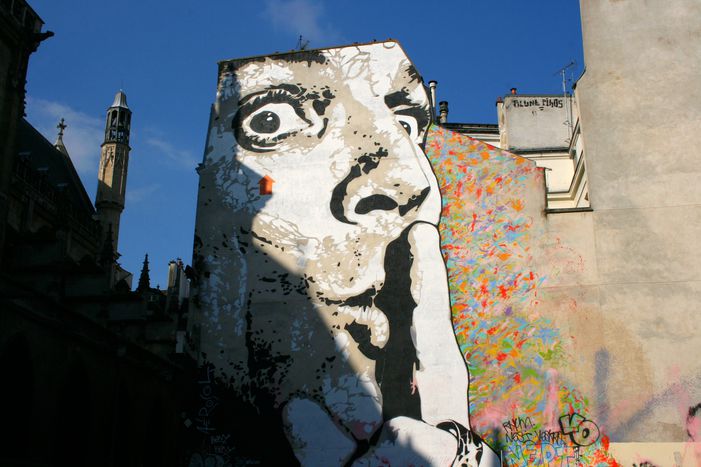
Buildings in Paris
Published on
Parisians and tourists alike may soon find, from the summit of the hill of Monmartre, new towers register in the French capital’s panorama. The construction of high-rise building is, in fact, being planned. Skyscrapers are rising up from most European metropolis.
Each city concerned is confronted by the double challenge: to best integrate contemporary buildings in a historical urban setting and to respect the environment in building towers that are economic in energy consumption.
The city of Paris voted last July to authorise the construction of new groups of high-rise buildings. Six sites, situated at the gates of Paris, have been selected: Bercy-Charenton (12th arrondissement), Masséna (13th), Porte de Versailles (15th), Batignolles (17th), Porte de la Chapelle (18th) and Porte de Montreuil (20th). In this context, the Mayor’s office has officially announced the construction of a new tower named “Triangle”, last 19 September, the new structure will be build in the 15th arrondissement near the Porte de Versailles. Named for its pyramidal form, this spectacular tower has been conceived by the architects, Herzog and De Meuron (who were also behind the construction of the Olympic stadium in Pekin). The building will measure 180 metres and will have 50 floors. This new skyscraper will accommodate various company offices. The inauguration of this ambitious piece of architectural work is planned for 2012.
Two-fold objective: answer the housing shortage and redynamise the image of Paris
The six sectors selected to host the new skyscrapers are situated in the different exits of the city, between the railway tracks and the péripherique (motorway encircling Paris); these sites constitute the last free space capable of accommodating an urbanism project of such scale in a city that is one of the most dense in the world (20 433 inhabitants/km2). The project of constructing new towers is the answer to the housing crisis that Paris is experiencing; the verticality of the structures will permit the creation of numerous housings on limited space. Moreover, the point of the project is also to freshen up the image of Paris all over the world: Paris is as much an economic pole anchored in modernity as a city «museum». The skyscraper are built by companies having the intention to reinforce their image, they also embody the economic vitality of the cities which accommodate them; these buildings become, as much as the historical architectural works, their best ambassadors throughout the world. (Chrysler Tower in New York, Petronas in Kuala Lumpur)
A passion of the European metropolises for skyscrapers
All of the big European metropolises are presently witnessing architectural projects of great scale spring up. Some European cities, are more uninhibited than others vis-à-vis the question of skyscrapers; the town of London, for example, decided, well before Paris, in the 80s, to build a new district of skyscrapers in it’s outskirts: Canary Wharf in Docklands. Today, new projects of big towers concern the downtown area and the district of Saint-Paul, with a delivery date predicted by 2010. The economic advancement of the Spanish metropolises (Barcelona, Madrid, Seville) involved the construction of skyscrapers and other buildings with ambitious forms. Torre Agbar, in Barcelona, designed by the French architect Jean Nouvel and inaugurated in 2005, became one of the symbols of the Catalan capital. Its structure is freely inspired by the works carried out by the famous local architect Gaudi. Today, with the recent surge of investors, Eastern European cities are, in their turn, opening up to the construction of buildings. Thus, skyscrapers are «springing up»in Warsaw (the Metropolitan tower of the architect, Foster), Bucharest (the new district Esplanada City Center) or Prague.
Urban Development and the Respect of the Environment
It is established that 70% of the CO2 emissions in the world come from the cities. One can then legitimately ask whether the construction of such buildings does not reinforce the deterioration of the environment. The elected Green officials of Paris savagely decided against the building of skyscrapers. The Mayor’s office on the other hand assured that projects, as it is the case for the Triangle tower, will have, to be retained, to respect the climate plan adopted by the city. The purpose of this ambitious plan, adopted on October 1, 2007, is to fight against global warming. The city of Paris engages, by this text, to reduce by 2020, 30% of its total greenhouse gas emissions compared to 2004. Initiatives are developed today on a European scale, in particular via the network Eurocities (network created in 1986 with an aim of supporting experience sharing between the cities of more than 250.000 inhabitants). 135 European cities (including Barcelona, Frankfurt and Milan) are members of this network. These cities recently signed a declaration in order to fight against climatic change; through this declaration, the cities are committed to develop and be sharing more respectful policies of the city of the environment. The projects of towers, essential to answer the lack of space in the European metropolises, must bring ecological guarantees also today to be accepted.
Actu-Environnement Site : (01/10/2007) Euronews Site: (31/10/2008) Europe 1 Site : (24/09/08)Sources and Links :
The City of Paris adopted its Climate Plan
European initiatives vs climatic change
La construction de la Tour Triangle
Picture : La Défense, financial district on the outskirts of Paris (Mat/FlickR)
Thibaud SIMON
Translated by Joanna Cordero



